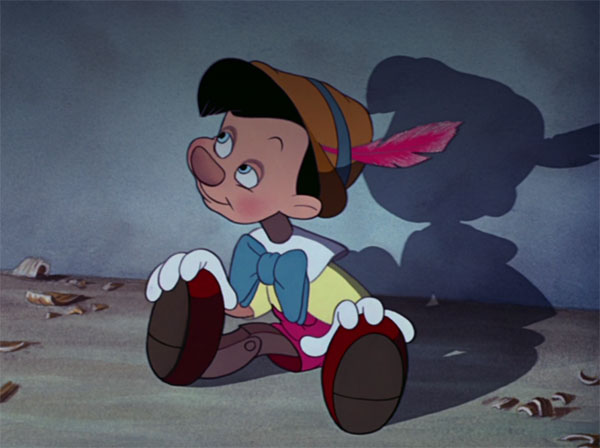
We’ve moving on to Disney’s second animated feature this week. Snow White and the Seven Dwarfs provided a great start to this series, with some very dark moments. That trend continues with Pinocchio, which still feels like an unlikely choice for a Disney picture. Released in February 1940, this adaptation of the novel by Carlo Collodi was more than double the cost of its predecessor. Unfortunately, it didn’t come close to the financial success. A big reason was the start of World War II, which closed off the international markets to Disney. It would ultimately build a reputation and earn the company a lot of money in re-releases.
Despite the financial issues, Pinocchio was an important release in Disney history. Its song “When You Wish Upon a Star” has become synonymous with the studio and Disney’s theme parks. It’s easy to forget the origins of that tune, which fits within this film but plays a different role for the company. Disney has taken the song’s message that “your dreams come true” and spread that to everything they do.
Looking solely at this movie, it’s hardly sentimental fare. This world includes constant villains and obstacles for the naive title character. He can’t even get to school without being sidetracked by a scheme or danger. Certain moments in this story are surprisingly nihilistic and might scare kids. Even so, it’s that edge that makes Pinocchio interesting. Its lead character is an empty shell learning about a difficult environment. Let’s dive further into Disney’s second attempt at feature animation!
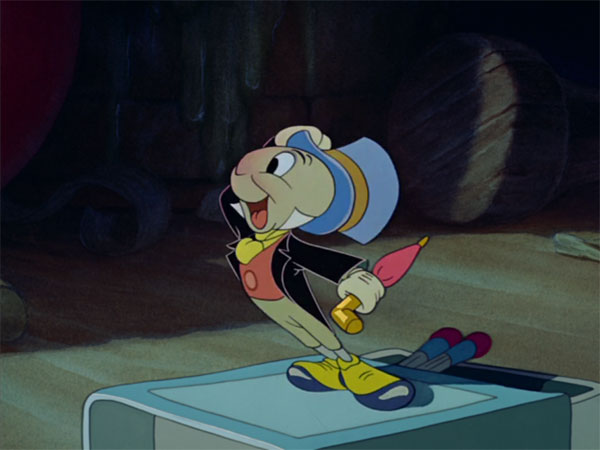
Becoming the Conscience
Since it’s the law, we begin with an open story book. There’s a nice change-up here with Jiminy Cricket (voiced by singer Cliff Edwards) breaking the fourth wall and singing to us directly from the top of the book. He’s our connection to this story, which is crucial since the main character is a puppet. Jiminy stumbles into Gepetto’s shop looking for a place to sleep and ends up in a fairy tale. The cuckoo clocks and various toys reveal Gepetto as a lonely guy building his own world. There’s likely a back story of loss for the toy maker judging by his emotional wish to make Pinocchio a real boy.
The Blue Fairy quickly appears and grants the wish to bring Pinocchio to life. She also recognize Jiminy Cricket’s goodness and makes him the conscience. This is all magical but also truly odd. Pinocchio is a blank slate, so it’s up to Jiminy to teach him about the world. This is not going to be easy. He sings “give a little whistle” and connects with Pinocchio, at least for the time being. It’s a brief set-up for a series of tests, which the puppet will likely fail.
The strangest part of this early scene is the reaction from Gepetto, who’s excited but decides to immediately send Pinocchio to school. That sounds like a terrible idea! Spending a few days helping the kid learn the ropes is probably a good move. Instead, the old man just gives Pinocchio an apple for the teacher and sends him off to school the next morning. I love how strange this moment is! There’s little concern from Gepetto that perhaps it’s a bad move. He’ll quickly learn that perhaps little Pinocchio is a bit gullible for the dangerous outside world.
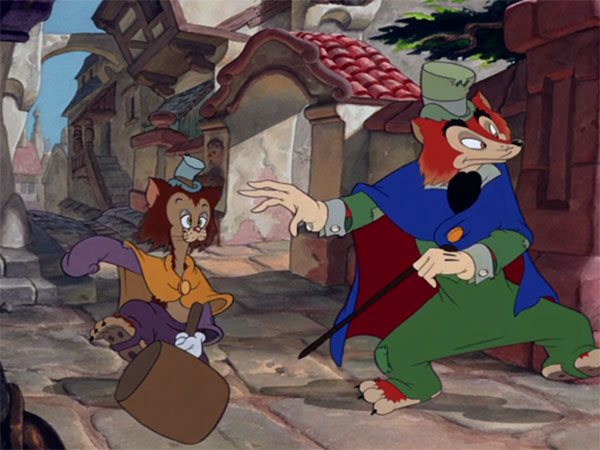
Temptation and Lying
I’d forgotten that Pinocchio’s long nose only appears once; it remains what many remember. This is an odd scene because Pinocchio’s stories don’t make sense, and he lies about random things like being made into firewood. The Blue Fairy (and everyone else, including us) sees through the lies, and birds even grab a spot on his nose. While the moral of this scene is clear (don’t lie, kids!), it’s not a frightening moment. It just feels like an odd detour that doesn’t really deter any future bad choices.
The temptation comes from Honest John, a fox who entices Pinocchio with tales of fun and fame. The puppet performs “I Got No Strings” and gets a big reaction, but he’s just a pawn for Stromboli here. After getting trapped in a cage and treated poorly, it’s baffling to see Pinocchio again fall into the trap. Gepetto also deserves blame for still trying to send him to school on the next day. Maybe take a day off after his capture? I’m reading too much into this fable, but I still was baffled at the parental choices.
There’s an interesting moment with Honest John partying with friends that doesn’t include any of the lead characters. It’s really just a set-up for the upcoming Pleasure Island sequence but is notable for the side trip. The creepy coachman is looking for young boys for his nefarious scheme, which only becomes clear later in the story. There’s little time wasted during this middle act, as it’s all a set-up to send Pinocchio on a harrowing journey.
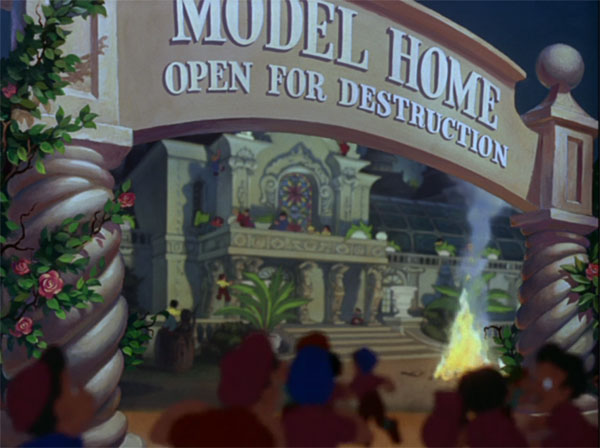
A Harrowing Sequence
The part that I remembered the most from past viewings was the Pleasure Island sequence, but I’d still forgotten a lot. Honest John and his pal Gideon convince Pinocchio to visit. He joins Lampwick and other wayward boys for something different than a typical amusement park. Tobacco Row gives them a chance to smoke, and the Model Home Open for Destruction offers unfettered mayhem. I’d completely forgotten about the latter spot, which is clever and enticing to young boys. We already know this will not go well, but the result is scarier than expected.
The transformation scene is constructed brilliantly to freak everyone out, including adults. The Giant 8 Ball pool hall gives Pinocchio and Lampwick a place to drink and smoke. This earns a warning on Disney Plus, but I doubt any kid will be tempted given the final outcome. We see most of Lampwick’s changes in shadow, and that just increases the impact. Once Pinocchio sprouts ears and a tail, we’ve already seen the awful end result with his “best friend”.
I’m not sure kids will ever want to leave their houses again (COVID-19 notwithstanding) after seeing this movie. Every time Pinocchio goes anywhere, something bad happens. His decisions cause some problems, but danger lurks around every corner. This trend culminates with Gepetto being swallowed by Monstro while searching for Pinocchio. It’s not just kids that are in danger! It’s so interesting to see Disney going into such dark territory with only their second animated feature. Snow White also had its moments, but this sits on another level.
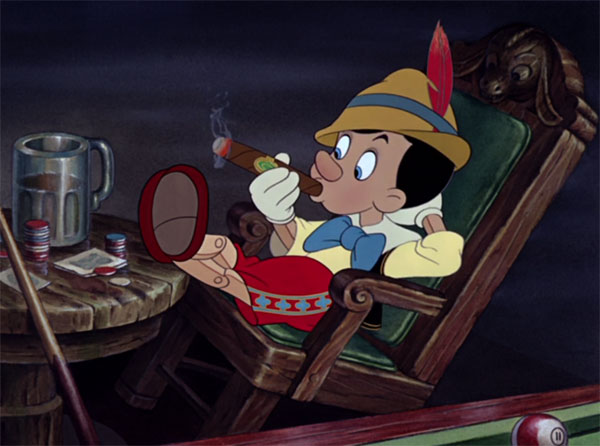
Proving His Worth
The final act shifts the story to the action genre as Pinocchio and Jiminy try to save Gepetto, Figaro, and Cleo (unsure why he brought the fish) from Monstro the whale. This epic scene goes on for a while, but it does include remarkable animation. Monstro is basically a massive vacuum cleaner or tractor beam that pulls in everything. Living inside doesn’t seem too bad, if you don’t mind the lack of food and water. The idea to make Monstro sneeze is smart, though it also leads to a very angry whale.
Keeping in line with the simple moral of the story, Pinocchio sacrifices himself to save Gepetto and proves he can be a real boy. The Blue Fairy revives him and deliver a happy ending. Jiminy even gets an official conscience badge. The Oscar-winning sounds of “When You Wish Upon a Star” return, and we have reached the end. Pinocchio might actually get to school in the future, but that’s a story for another day.
It’s interesting to note that Stromboli, Honest John, Gideon, and the coachman will keep tricking kids and hurting them. Monstro ultimately crashes into a cliff, though he isn’t really evil like the others. Despite the victory for Pinocchio, his world remains a dangerous place. If this story had continued, I suspect this wouldn’t be the last time that Pinocchio would face villains and other challenges. It’s just part of being a real boy.
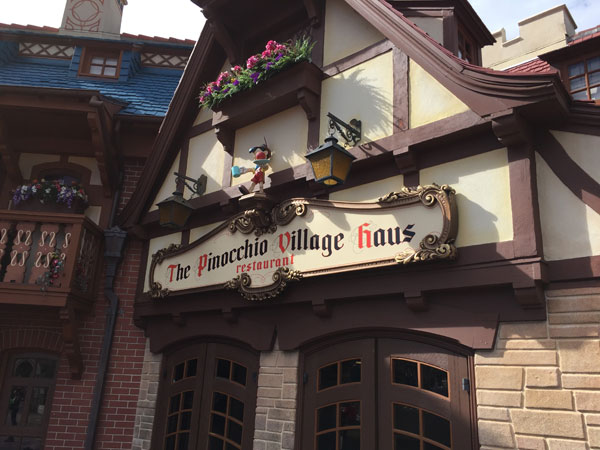
A Daring Journey, Village Haus, and Monstro
Pinocchio has a significant presence in the parks, though it’s more limited at Walt Disney World. The most prominent example is Pinocchio’s Daring Journey, a dark ride that opened in Anaheim and Tokyo in 1983. At Disneyland, it was the major addition for the New Fantasyland project and replaced the Mickey Mouse Club Theater. The second-generation dark ride employs updated effects but retains the general formula of the early Fantasyland attractions. It was also part of that land in Disneyland Paris when that park opened in 1992.
I’ve ridden Pinocchio’s Daring Journey in California and Paris, but only once each time as an adult. It’s a blind spot that I hope to rectify. In Florida, this film appears mostly as the Pinocchio Village Haus restaurant. Although it offers a cool view of “it’s a small world” for some lucky guests, the pizza and other options are generic. Similar eateries also appear in California, Paris, and Shanghai, though I haven’t eaten there.
Monstro is also a major icon at Disneyland as part of its Storybook Land Canal Boats attraction. Guests travel right through the whale’s mouth while experiencing miniature versions of various Disney films. If that wasn’t enough, Monstro appears as part of Fantasmic! with a larger role at Disneyland. All of these appearances, along with some character meetings, show the impact of Pinocchio in the parks. Eighty years after its original release, the film still connects with viewers of all ages.
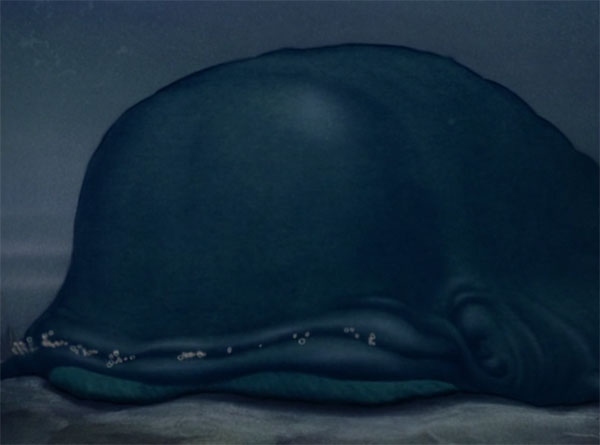
Rankings
Now that we’ve reached the second entry in my look back at Disney’s animated features, let’s do the rankings! The gap between the two movies isn’t that wide. I considered selecting Pinocchio for the top spot because it’s so interesting and odd. Along with the movies, I’m adding a category that ranks the lead characters. We haven’t done amazing with either option since both are overshadowed by secondary roles. It’s also time to start ranking the main villains; there are multiple choices in this movie. I’ll keep expanding the categories as we dig further into this project.
The Movies
1. Snow White and The Seven Dwarfs
2. Pinocchio
Lead Characters
1. Snow White
2. Pinocchio
Villains
1. The Queen
2. Monstro
3. Honest John
4. Stromboli
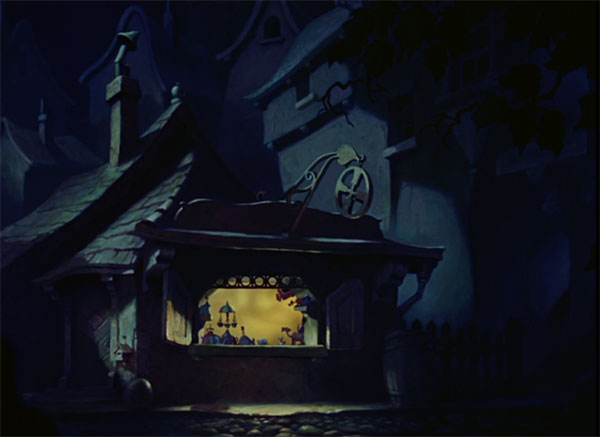
Favorites
I’ve split up the rankings and favorites into two sections because we have two movies. It’s time to focus only on Pinocchio and give it credit for being a good film!
- Song: “When You Wish Upon a Star”, written by Leigh Harline and Ned Washington; performed by Cliff Edwards
- Scene: The entire Pleasure Island sequence
- Character: Jiminy Cricket
- Shot: The camera bounces up and down while Jiminy approaches Gepetto’s toy shop.
- Surprise: The overall nihilism of the world depicted, not just at Pleasure Island
What do you think about Pinocchio? Leave your comments below!
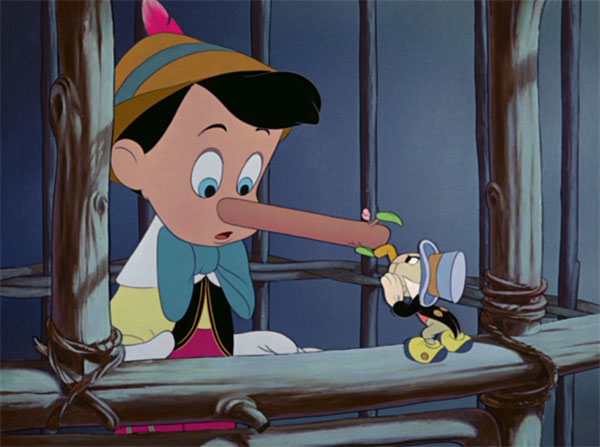
Related Articles: Pinocchio
Snow White and the Seven Dwarfs (Disney Animation #1)
This post contains affiliate links. Making any purchase through those links supports this site. See full disclosure.



Leave a Reply